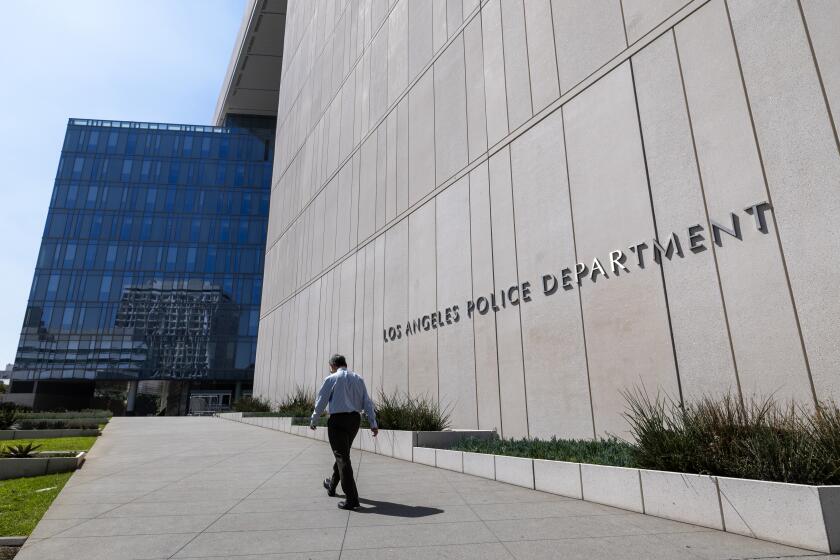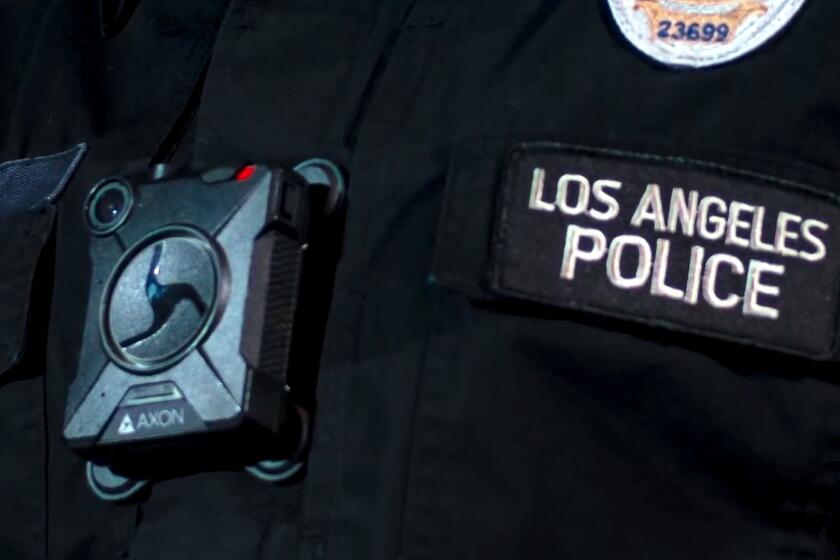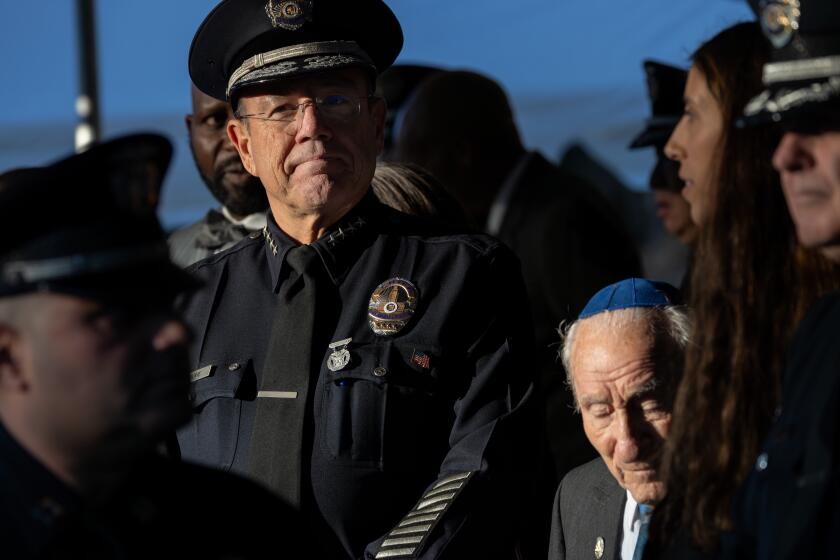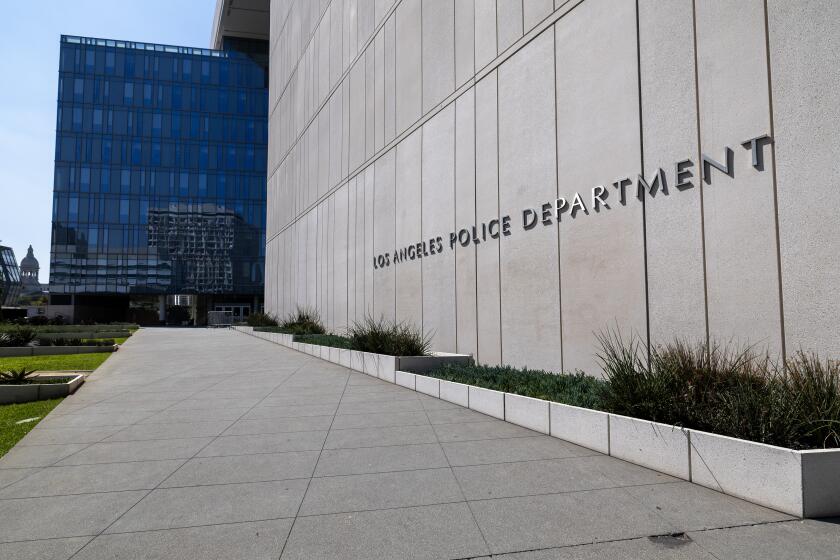Countless hours of LAPD body camera videos go unwatched. Could AI be the answer?
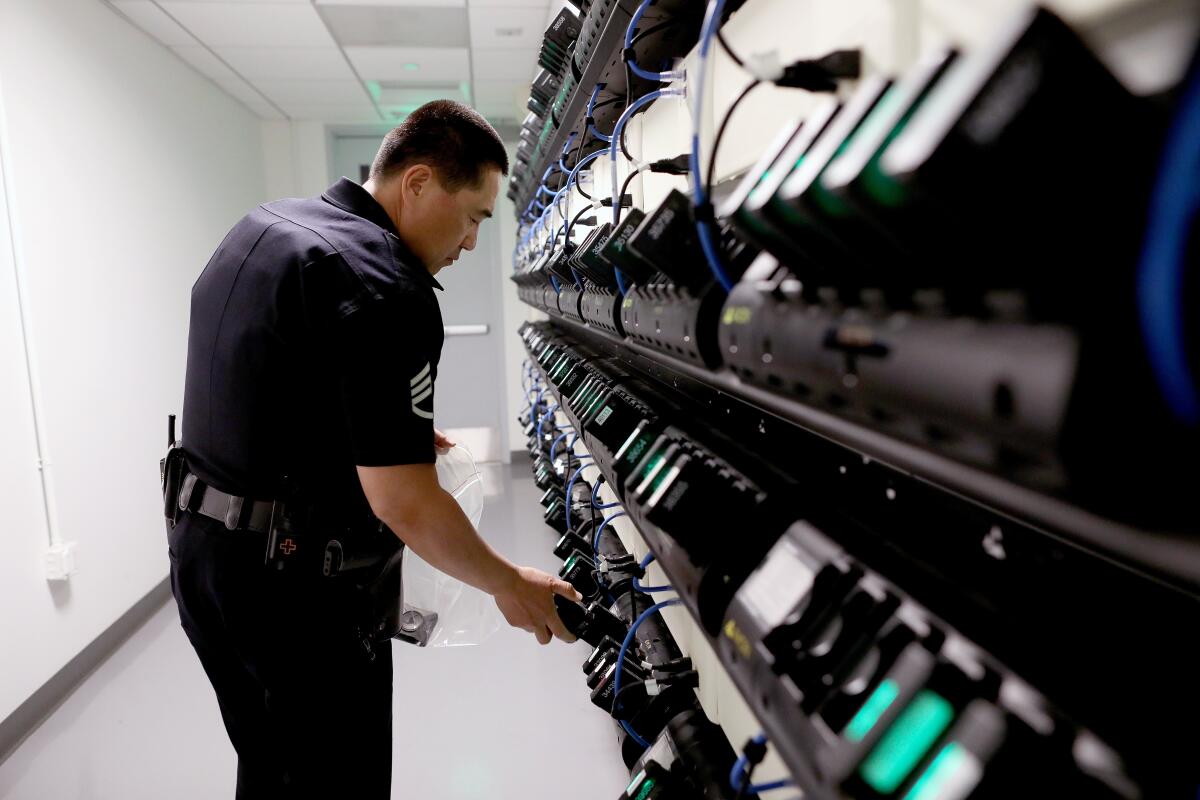
On any given day, Los Angeles police officers record roughly 8,000 interactions with the public on body-worn cameras. Most of the footage goes unseen.
The city spent millions on the cameras to help provide transparency and accountability, but LAPD officials say they donât have enough personnel to monitor the countless hours of recordings. The department has also struggled to keep tabs on whether officers are turning off their cameras in violation of department rules â as members of a disbanded gang unit from the Mission division are suspected of doing in order to cover up thefts, unlawful searches, and other alleged misconduct.
A recent internal report suggested lapses in body-cam activation are more widespread than the department has previously let on, and that its system for auditing compliance falls short. In the aftermath of the Mission scandal, LAPD leaders have been eyeing a potential solution: artificial intelligence, which can analyze vast troves of body camera footage with a few keystrokes. Police agencies across the country hope that new advancements with the technology will help identify officer misconduct that is captured on camera.
Police Chief Michel Moore said the Mission officers are suspected of âgamingâ the departmentâs camera rules, which require random reviews of body-cam activation on stops involving gang suspects â but only in cases where no enforcement action is taken. The policy is intended to monitor the conduct of gang units as they interact with the public, but Moore said Mission officers searched vehicles without justification, thinking their body-cam footage would not be reviewed. Their actions were discovered after a motorist filed a complaint with the department alleging they were pulled over last December and their car was illegally searched.
The department began reviewing the unitâs body camera footage and other information, and it found discrepancies with what officers wrote in their reports. The FBI is investigating, and the department has moved to fire at least two of the involved officers, who are also facing criminal charges.
For months, someone has been filing anonymous complaints against members of the LAPD command staff under the pseudonym âMel Smith.â
Asked earlier this year whether the Mission case could open the door to using advanced software to audit the departmentâs camera footage, Moore said âartificial intelligence is a very scary term to many people because they think itâs somehow autonomous and that itâs going to take its own path.â But he still sees potential.
âWhat can systems do to help show anomalies?â he asked. âIâm always interested in understanding how that can happen.â
Most signs suggest the department is seriously considering the technology.
Earlier this year, the LAPD announced a joint study with researchers from USC and three other universities that will use machine learning systems to analyze the language that officers use during traffic stops. The study, which will take three years to complete, will review body camera footage from roughly 1,000 traffic stops for problematic word choice or tone.
A department official told the Police Commission in August that AI will âundoubtedly become a profound element in officer training in the future.â
Efforts to use AI for video review are likely to draw opposition from the Los Angeles Police Protective League, the union that represents most of the cityâs rank-and-file officers.
Two sources familiar with the arrangement, who requested anonymity because they were not authorized to discuss it publicly, said the police union cautiously agreed to the USC study. But the union insisted that the resulting analysis be used for training purposes, with disciplinary action taken only against serious misconduct captured on video. The Protective League was concerned that the department would hand down retroactive punishment for officers who were rude or failed to explain their actions when stopping people.
Before announcing the study, the union urged the department to consider contracting with Truleo, a Chicago start-up that is already working with law enforcement agencies in Florida and Colorado, according to the two sources. One source, who asked not to be named in order to discuss internal department matters, said the LAPD is still considering Truleo, but is waiting to see how the service performs in other cities before committing. The New York Police Department, the countryâs largest police force, signed on to the service last month, according to news reports.
The Los Angeles Police Department is considering changing department policy to increase random reviews of body camera recordings.
Truleo grew out of an earlier effort by Wall Street banks to âprofessionalizeâ their workplaces, but the company began working with police departments after the murder of George Floyd in Minneapolis in 2020, according to founder Anthony Tassone.
The company processes transcripts of interactions caught on body camera, looking for cues and patterns. The software uses voice-print technology to tag an officerâs language as an âinsult,â âprofanity,â or âgratitude,â while also flagging uses of force and searches.
âSo frisking language might be like, âDo you have any needles that might hurt me?â These cops, theyâre like call center employees, their vocabulary is very finite: itâs like 400 words,â Tassone said in an interview. âCops are smart. They know right now nobody is watching their body camera videos.â
Departments can use the resulting analyses to train officers on how to navigate potentially fraught encounters without resorting to force, he said.
The technology has met resistance in some places. According to news reports, Seattle, an early adopter, terminated its contract with Truleo in September, a short time after a police union official was inadvertently recorded on camera joking about a young woman killed by another officer.
Art Acevedo, chief of police in Aurora, Colo., another Truleo client, said AI promises to address what has been a glaring weakness of police cameras: Most of the time, no one is watching. He said that larger departments like Los Angeles and Houston typically only review video in connection with an investigation related to a pursuit, civilian complaint or use-of-force incident â but rarely to evaluate professionalism.
âYou canât, as a police department or a police union leader, climb from the top of the mountain and scream what a great department we have and turn around and say, âHey we donât want our body camera footage to be seen,ââ said Acevedo. Such analysis, he said, could also highlight examples of good policing or identify troubled officers and get them the help they need before their behavior gets worse, he said. âLike a study your own game film type of situation.â
Prosecutors begin review of over 300 cases identified as potentially compromised amid LAPD gang unit scandal, according to multiple law enforcement sources.
Jonathan Wender, CEO of Polis Solutions, a competitor to Truleo that recently started working with Dallas police, said his companyâs system works by evaluating factors such as a personâs âemotional intensityâ to study the behavior of both officers and subjects they encounter.
âWhy wouldnât you mine body camera footage, the largest single source of data in the world on police-community interactions?â he asked.
As the use of body cameras has expanded across the country, citizens and many police leaders say they have brought much-needed transparency to police encounters with the public, making the devices well worth the millions they cost to purchase and maintain. With the rise of AI, civil liberties groups have raised concerns about the privacy rights of citizens who are not only being recorded, but whose actions will now be evaluated without their consent. And other critics say it has yet to produce better behavior by police.
Cities have been âseducedâ by claims made by AI analysis companies that so far have offered no proof the analysis will actually change how officers conduct themselves, according to Chris Schneider, a sociology professor at Brandon University in Manitoba, Canada.
The technology is only as unbiased as the people who program it, he said, pointing out that the complexities of racism go beyond an officerâs word choice. âPolice officers can and do racist things without using racist language,â he said. âWe know that police officers have already come up with ways to avoid being recorded or let other police officers know that they are recording.â
Hamid Khan, of the watchdog group Stop LAPD Spying Coalition, said that such accountability tools fail to address systemic problems with law enforcement.
âIt gives false illusions of monitoring of misconduct and accountability,â he said. âBut in essence nothing changes, and corporations make more money off of it.â
A recent LAPD presentation showed that the department performs roughly 8,800 random audits of body-worn cameras per year. But these reviews only checked to see if officers were promptly activating their cameras, and if their recordings included a full two-minute buffer â a constantly recorded loop that helps capture what occurs before the officer thinks to activate their camera. Another approximately 1,500 spot checks were done specifically on video from gang stops, police officials said.
An internal report released earlier this year said the department had inconsistent policies, which allowed camera misuse to go undetected. But it also suggested the department conduct a âfeasibilityâ study before giving patrol supervisors the added responsibility of checking videos that donât involve a complaint or use of force.
An LAPD detective filed a legal claim against the city alleging sexual abuse in the locker room of the departmentâs football team.
Even as he publicly maintained that the departmentâs current camera rules are strong, Moore has signaled that changes are likely.
Speaking at a Police Commission meeting Tuesday, Moore said placing the added workload of reviewing footage on supervisors âwould just entirely drown the system.â
âThey would never be out in the field, they would just be watching videos,â Moore told the civilian oversight body.
At the same meeting, department officials presented an analysis comparing the LAPDâs camera policy with police in New York, Houston and other big-city departments across the country.
Several other agencies conducted more routine reviews than the LAPD. Commission President Erroll Southers said he was worried to learn that the departmentâs review of gang stops relied on a relatively small sample size. He questioned whether it was enough to uncover potential misconduct.
âAre we looking at too few that we canât identify a trend or are we missing it?â Southers said.
Southers said he was also concerned that Philadelphia, a smaller department, required their patrol sergeants to examine 60 body-worn videos every year.
âDo we understand how theyâre able to crank out a lot more reviews than we are with a department a third their size?â Southers asked.
Departments like Philadelphia donât match âthe rigor as far as the standardizationâ of the LAPD review process, Moore said. The same, he said, goes for Chicago police, which conducted 23,700 video reviews a year â more than twice as many as Los Angeles.
More to Read
Sign up for Essential California
The most important California stories and recommendations in your inbox every morning.
You may occasionally receive promotional content from the Los Angeles Times.
